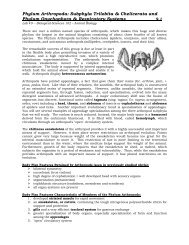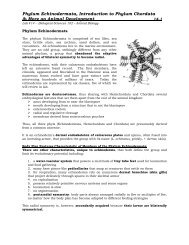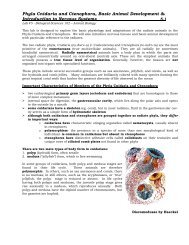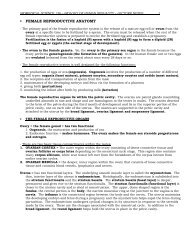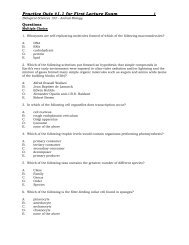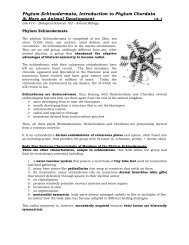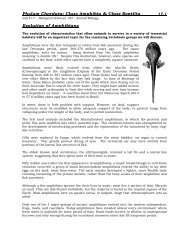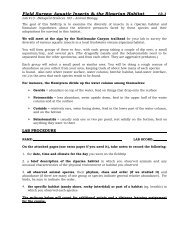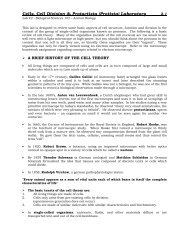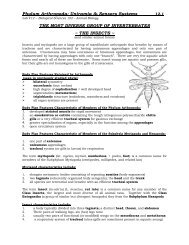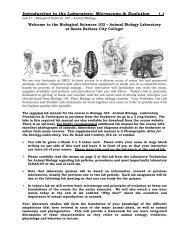Reptiles, Dinosaurs, Birds & Animal Locomotion and ... - Biosciweb.net
Reptiles, Dinosaurs, Birds & Animal Locomotion and ... - Biosciweb.net
Reptiles, Dinosaurs, Birds & Animal Locomotion and ... - Biosciweb.net
You also want an ePaper? Increase the reach of your titles
YUMPU automatically turns print PDFs into web optimized ePapers that Google loves.
Phylum Chordata: Class Reptilia & Class Aves 18.1Lab #18 -- Biological Sciences 102 – <strong>Animal</strong> BiologyIn lab today you will be studying birds <strong>and</strong> reptiles <strong>and</strong> you will also continue towork on Lab #26 to further process your DNA Barcoding samples. Most of thequestions in this lab will be completed as homework outside of our lab hours.From Scales to Feathers….Lacertilia by HaeckelClassification of <strong>Reptiles</strong> <strong>and</strong> <strong>Birds</strong>Reptile TaxonomyClass ReptiliaSubclass Anapsida (a-nap'se-duh) (Gr. an, without, + apsis, arch):anapsids. Amniotes having some primitive features, such as askull with no temporal opening.Order Testudines (tes-tu'din-eez) (L. testudo, tortoise) (Chelonia): turtles. Body in a bonycase of dorsal carapace <strong>and</strong> ventral plastron; jaws with keratinized beaks instead of teeth;vertebrae <strong>and</strong> ribs fused to overlying carapace; tongue not extensible; neck usuallyretractable; approximately 300 species.Subclass Diapsida (di-ap'se-duh) (Gr. di, double, + apsis, arch): diapsids. Amniotes having askull with two temporal openings.Superorder Lepidosauria (lep-i-do-sor' ee-uh) (Gr. lepidos, scale, + sauros, lizard). Diapsidlineage appearing in the Triassic; characterized by sprawling posture; no bipedalspecializations; diapsid skull often modified by loss of one or both temporal arches;transverse cloacal slit, skin shed in one piece.Order Squamata (skwa-ma'ta) (L. squamatus, scaly, + ata, characterized by): snakes,lizards, amphisbaenians. Skin of horny epidermal scales or plates, which is shed;quadrate movable; skull ki<strong>net</strong>ic (except amphisbaenians); vertebrae usually concave infront; paired copulatory organs.Suborder Lacertilia (lay-sur-till' ee-uh) (L. lacerta, lizard) (Sauria): lizards. Bodyslender, usually with four limbs; rami of lower jaw fused; eyelids movable; external earpresent; this paraphyletic suborder contains approximately 4600 species.Suborder Amphisbaenia (am'fis-bee'nee-a) (L. amphis, double, + baina, to walk): wormlizards. Body elongate <strong>and</strong> of nearly uniform diameter; no legs (except one genus withshort front legs); skull bones interlocked for burrowing (not ki<strong>net</strong>ic); limb girdlesvestigial; eyes hidden beneath skin; only one lung; approximately 160 species.Suborder Serpentes (sur-pen'tes) (L. serpere, to creep): snakes. Body elongate; limbs,ear openings, <strong>and</strong> middle ear absent; m<strong>and</strong>ibles joined anteriorly by ligaments; eyelidsfused into transparent spectacle; tongue forked <strong>and</strong> protrusible; left lung reduced orabsent; approximately 2900 species.
Phylum Chordata: Class Reptilia & Class Aves 18.2Lab #18 -- Biological Sciences 102 – <strong>Animal</strong> BiologyOrder Sphenodonta (sfen'o-don'tuh) (Gr. sphen, wedge, + odontos, tooth): tuatara(Rhynchocephalia). Primitive diapsid skull; vertebrae biconcave; quadrate immovable;parietal eye present; two extant species in the genus Sphenodon.Superorder Ichthyosauria (ik'thee-o-sor'ee-uh) (Gr. ichthys, fish, + sauros, lizard). Mesozoicmarine dolphin-shaped diapsids with reduced limbs. All extinct.Superorder Sauropterygia (sor-op-ter-ig'ee-uh) (Gr. sauros, lizard, + pteryginos, winged).Mesozoic marine reptiles. All extinct.Order Plesiosauria (plees' ee-o-sor' ee-uh) (Gr. plesios, near, + sauros, lizard). Long-neckedMesozoic marine reptiles with paddlelike limbs. All extinct.Superorder Archosauria (ark'uh-sor'ee-uh) (Gr. archon, ruling, + sauros, lizard). Advanceddiapsids, mostly terrestrial, but some specialized for flight; gizzard present.Order Crocodilia (crok'uh-dil'ee-uh) (1. crocodilus, crocodile): crocodilians. Skull elongate<strong>and</strong> massive; nares terminal; secondary palate present; four-chambered heart; vertebraeusually concave in front; forelimbs usually of five digits; hindlimbs of four digits; quadrateimmovable; advanced social behavior; 23 species.Order Pterosauria (ter'uh-sor' ee-uh) (Gr. pteron, winged, + sauros, lizard). Flying, Mesozoicarchosaurs with membranous wings; extensive radiation. All extinct.Order Saurischia (sor-ish'ee-uh) (Gr. sauros, lizard,+ ischion, hip). Mesozoic dinosaurs;bipedal carnivores <strong>and</strong> quadrupedal herbivores; primitive (reptilian) hip structure.All extinct.Suborder Sauropodomorpha (sor'uh-pod-uh-morf'uh) (Gr. sauros, lizard, + podos, foot, +morphe, form). Herbivorous saurischians including Mesozoic giants such asBrachiosaurus, Apatosaurus <strong>and</strong> Diplodocus.Suborder Theropoda (the-ro'po-duh) (Gr. ther; wild beast, + podos, foot). Carnivoroussaurischians including huge predators such as Tyrannosaurus <strong>and</strong> small, agilepredators such as Deinonychus <strong>and</strong> Velociraptor. <strong>Birds</strong> are descended from thislineage.Order Ornithischia (orn'uh-thish'ee-uh) (Gr. ornis, bird, + ischion, hip). Mesozoic dinosaurs;bipedal <strong>and</strong> quadrupedal herbivores such as Stegosaurus, Triceratops, <strong>and</strong>Parasaurolophus; advanced (birdlike) hip structure. All extinct.Subclass Synapsida (sin-ap'si-duh) (Gr. syn, together, + apsis, arch). Amniotes having skullwith one pair of lateral temporal openings.Order Therapsida (ther-ap'-si-duh) (Gr. ther; wild beast, + apsis, arch): synapsids. Permian<strong>and</strong> Triassic synapsids with many mammal-like characteristics; carnivores <strong>and</strong>herbivores. Living mammals are descended from this lineage.
Phylum Chordata: Class Reptilia & Class Aves 18.3Lab #18 -- Biological Sciences 102 – <strong>Animal</strong> BiologyBird TaxonomyClass Aves (L. avis, bird)Subclass Archaeornithes (Gr. archaios, ancient, + ornis, bird). <strong>Birds</strong> of thelate Jurassic <strong>and</strong> early Cretaceous bearing many primitivecharacteristics. ArchaeopteryxSubclass Neornithes (Gr. neos, new, + ornis, bird). Extinct <strong>and</strong> livingbirds with well-developed sternum <strong>and</strong> usually with keel; tail reduced;metacarpals <strong>and</strong> some carpals fused together. Cretaceous to present.Over 30 different orders with about 9000 species (see end of lab).Class Aves <strong>and</strong> Major Bird Orders‣ Briefly describe some important characteristics of this Class of vertebrates.Lab practicum practice: list 10 different bird orders in the space below:(see the end of this lab)1.2.3.4.5.6.7.8.9.10.
Phylum Chordata: Class Reptilia & Class Aves 18.5Lab #18 -- Biological Sciences 102 – <strong>Animal</strong> BiologyBrainstorm on this page with classmates at your table about the topic assigned by yourinstructor regarding the evolutionary origin of birds <strong>and</strong> their similarities to reptiles.Basically think about how you would “turn a reptile into a bird”. What anatomicalchanges had to evolve <strong>and</strong> what changes must have taken place? What novel structures,characteristics or behaviors evolved in birds that are different than reptiles? Useeducated guesses <strong>and</strong> your current knowledge to determine what features in a reptilebecame specific features in a bird.‣ You may draw pictures, but there must be notes regarding your discussion on thispage for full lab credit.
Phylum Chordata: Class Reptilia & Class Aves 18.6Lab #18 -- Biological Sciences 102 – <strong>Animal</strong> BiologyAnswer the following questions using your lab manual, textbook, instructor feedback, theInter<strong>net</strong> <strong>and</strong> collective discussions with your classmates.Regarding Thermoregulation:Briefly define the following terms:Ectothermy (most invertebrates, fish, amphibians <strong>and</strong> many reptiles) =Endothermy (some reptiles, birds, mammals) =Homeothermy (a special type of endothermy in birds <strong>and</strong> mammals only) =Regarding Reproduction:Briefly define the following terms:Oviparous =Ovoviviparous =Viviparous =Regarding Lifecycle <strong>and</strong> Development in <strong>Birds</strong>:Altricial =Precocial =
Phylum Chordata: Class Reptilia & Class Aves 18.7Lab #18 -- Biological Sciences 102 – <strong>Animal</strong> BiologyEvolution of Bird FlightThere are two basic, general hypotheses that attempt to explain the evolution of birdflight. In the spaces below, briefly define <strong>and</strong> describe what information you can findabout these two different hypotheses…or others if you find them.Evolution of Bird Flight: Hypothesis #1:Evolution of Bird Flight: Hypothesis #2:Archaeopteryx Fossil
Phylum Chordata: Class Reptilia & Class Aves 18.8Lab #18 -- Biological Sciences 102 – <strong>Animal</strong> BiologyBird Anatomical FeaturesPhylum ChordataSubphylum VertebrataClass AvesUsing diagrams from the text/lab/inter<strong>net</strong> <strong>and</strong> a bird specimen from lab, find thefollowing bird features:External Bird Structures‣ head (are scales or featherspresent on your specimen?)‣ eye‣ bill‣ nostril‣ neck‣ thorax‣ abdomen‣ lesser covert feathers‣ middle covert feathers‣ greater covert feathers‣ scapular feathers‣ primary feathers‣ secondary feathers‣ tail feathers‣ rump‣ legs‣ feet (are scales present?)‣ where are the wing slots?‣ where is the cloacal opening?Skeletal Structures (on pigeon skeleton <strong>and</strong> diagram in textbook/lab)‣ skull‣ sclerotic ring around orbit of the eye‣ axial skeleton‣ appendicular skeleton‣ nostril‣ orbit‣ maxilla‣ m<strong>and</strong>ible‣ vertebrae (ending in urostyle)‣ scapula‣ fused clavicle‣ coracoid‣ sternum with keel‣ ribs‣ humerus‣ radius <strong>and</strong> ulna‣ carpals‣ metacarpals‣ phalanges/digits‣ pelvis/pelvic girdle‣ pygostyle (reduced tail vertebrae in modern birds)‣ femur‣ tibiotarsus (shin bone)‣ tarsometatarsus (fused ankle bone)‣ phalanges/toes (on feet) (how many toes does your specimen possess?)‣ What is the alula?‣ Muscles (see diagrams in text)‣ pectoralis major (ventral chest)‣ supracoracoideus (ventral chest)
Phylum Chordata: Class Reptilia & Class Aves 18.9Lab #18 -- Biological Sciences 102 – <strong>Animal</strong> BiologyAdaptations for Flight‣ For each organ system listed below, identify <strong>and</strong> briefly describe anatomical orphysiological adaptations that increase flight efficiency. For each organ system, theremay be more than one adaptation to consider regarding flight.Skeletal =Muscular =Cardiovascular/Circulatory =The Alimentary Canalof a BirdExcretory =Reproductive =
Phylum Chordata: Class Reptilia & Class Aves 18.10Lab #18 -- Biological Sciences 102 – <strong>Animal</strong> BiologyFrom a developmental <strong>and</strong>/or evolutionary perspective, from what structures did featherdifferentiate/evolve?‣ Which type of bird would you expect to produce altricial or precocialoffspring? Briefly provide an explanation for your answer.Ground-nesting birdsOffspring type (altricial or precocial):One example of a ground-nesting species is:Explanation for your answer:Tree-nesting birdsOffspring type (altricial or precocial):One example of a tree-nesting species is:Explanation for your answer:‣ Be sure to review the bird skeletons displayed in the lab. Yourinstructor will point out a few key aspects of bird skeletons <strong>and</strong> thedifferent types of feathers.
Phylum Chordata: Class Reptilia & Class Aves 18.11Lab #18 -- Biological Sciences 102 – <strong>Animal</strong> Biology‣ Using the bird specimens displayed in the lab, provide the followinginformation for ONE bird species in each of the following different ordersOrder GaviiformesCommon NameScientific NameUnique structures or featuresOrder PodicipediformesCommon NameScientific NameUnique structures or featuresOrder PelecaniformesCommon NameScientific NameUnique structures or featuresOrder CiconiiformesCommon NameScientific NameUnique structures or features
Phylum Chordata: Class Reptilia & Class Aves 18.14Lab #18 -- Biological Sciences 102 – <strong>Animal</strong> BiologyOrder PiciformesCommon NameScientific NameUnique structures or featuresOrder PasseriformesCommon NameScientific NameUnique structures or featuresOrder SphenisciformesCommon NameScientific NameUnique structures or featuresOrder StruthioniformesCommon NameScientific NameUnique structures or features
Phylum Chordata: Class Reptilia & Class Aves 18.15Lab #18 -- Biological Sciences 102 – <strong>Animal</strong> BiologyLABORATORY NOTES:Trochilidae by Haeckel
Phylum Chordata: Class Reptilia & Class Aves 18.16Lab #18 -- Biological Sciences 102 – <strong>Animal</strong> BiologyLABORATORY NOTES:



